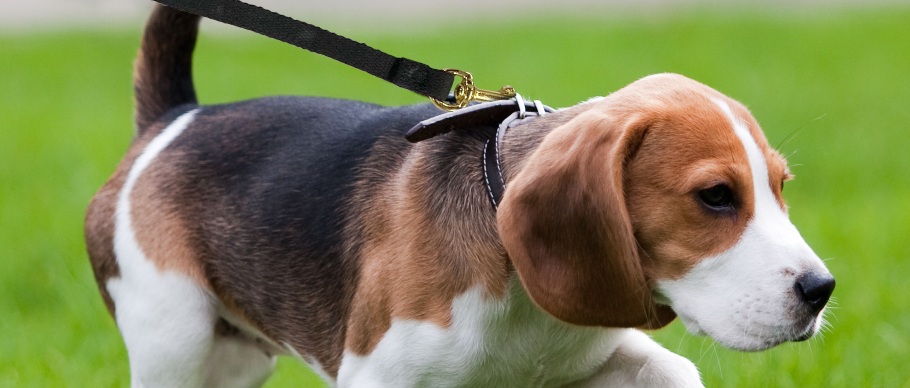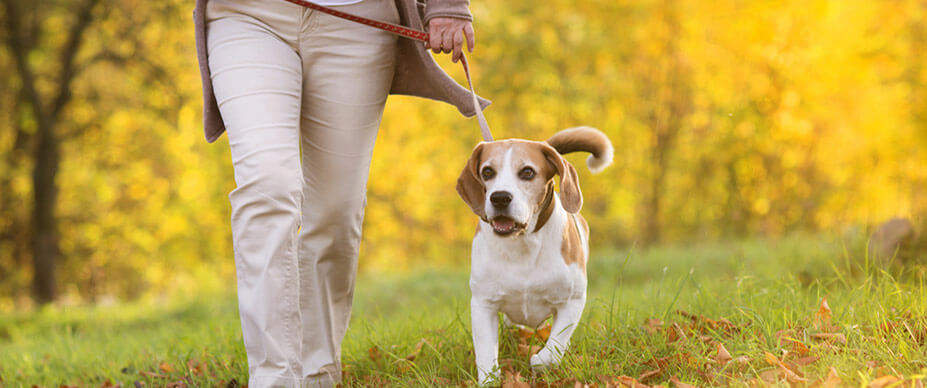4 Steps for Safely Walking a Dog
Walking your dog is not only a great way to enjoy some fresh air, but it’s also the perfect opportunity to bond with your furry friend! From a quick stroll in a busy neighborhood to longer, more strenuous hikes in the great outdoors, you can better prepare for the obstacles you may face along the way. Here are four steps you can follow to help make walking a dog a safe experience for both you and your pup.
Step 1: Gather the Proper Equipment
Having the right supplies for walking a dog is essential to starting your journey off on the right paw! The following dog walking accessories will help make for a safer and more comfortable stroll.
Leashes
Even the most obedient dog may not be able to resist the sight of a squirrel or cat across the street. With a sturdy leash, you’ll have peace of mind knowing your pup won’t put themselves or others in a dangerous situation. Plus, most jurisdictions require dogs to be on a leash when in public places.
While a leash may seem like a one-size-fits-all accessory, they actually come in a variety of styles, lengths, and widths depending on your needs and your dog’s size. A leash that’s 3/8 or 1/2 inches wide is suitable for smaller dogs, while larger, stronger dogs may require a 3/4-inch leash. Here are some of the most popular types of leashes:
Reflecting Leashes: Consider a reflecting leash for nighttime walking. Keep in mind that if you’re walking your dog at night, you should wear reflective clothing yourself.
Cotton Leashes: These leashes are a comfortable, nonslip, and inexpensive leash option. Our dog training leads are 100-percent cotton with a traditional swivel snap hook that provides extra durability, and they’re available in lengths up to 30 feet.

Harnesses
For those with pups who prefer less pressure on the neck, a dog harness is a good choice. They are also tougher to escape from, which makes them a safer option than collars during walks. Using a front-loop harness for habitual pullers makes it easy to control even the strongest dog with ease.
Collars
Even if you use a harness to walk the dog, they should never be without their collar. The collar carries important information, like their rabies tags and identification. The collar should fit snugly but not tightly; you should be able to slide two fingers between the collar and your dog’s neck.
Waste Pickup
Waste pickup may not be a safety concern for your furry friend, but there are still plenty of good reasons why dog poop cleanup is important. A traditional waste bag is certainly a must-have before heading out on your next adventure—you'll want to be prepared in case your dog has to go potty! If you have difficulty bending down to clean up, opt for an easy-to-use pooper scooper on your next stroll.
Step 2: Plan Your Walk
Once you’ve got your gear ready, be sure to create a walking route. It’s important to know your surroundings and have an idea of what you might encounter while out and about. If you go to a popular hiking spot, you may run into other people with their furry friends. If you have a shy or nervous dog, start your walks in a familiar location before you venture out to an unknown territory. Depending on your environment, you may also run into some plants that are toxic to dogs, so be sure to keep your dog on the path and away from any harmful foliage.
Step 3: Check the Weather
While we all love taking a walk on a warm summer day, the asphalt can quickly rise to temperatures that are too dangerous for your dog’s paws. On a 77-degree day, for instance, the ground can get as hot as 125 degrees in the sun. On very hot days, it’s best to walk the dog early in the morning or at dusk. You can also try to keep your pup on the grass as best you can to avoid the hot pavement. Snow-covered surfaces are safe for dogs to walk on, however the salt often used to melt ice during the winter can cause cracked or dry dog paws.
For a safer walk, apply a dog paw balm before you head out on hot or cold days. The guard creates a barrier between the paw pads and the ground, which helps protect your pup’s feet.
QUIZ: Keep Your Dog Safe in the Summer Heat
Step 4: Take Breaks When Needed
Taking a short break (even when your pup may still seem full of energy) is a good way to help keep your dog safe on longer walks. While our furry friends can’t verbally communicate how they are feeling, some physical signs of heat exhaustion include excessive drooling and uncoordinated movements. To help reduce the chances of heat exhaustion, be sure to bring a collapsible water bowl with you and look for shade during your breaks. If you’re walking your puppy for the first time, it’s important to start with a shorter walk and gradually increase the length of each trek.
A Step in the Right Direction!
Preparation will not only help promote a safer experience, but it will also ease your mind! With these tips, walking a dog will be the perfect opportunity for you and your pup to enjoy each other's company and the world around you.








